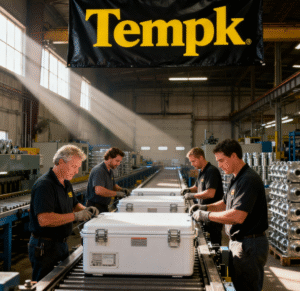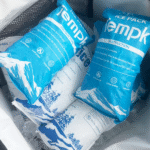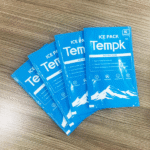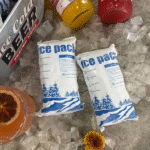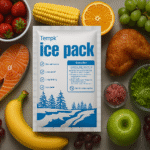ال لوجستيات السلسلة الباردة sector has never been more critical. سواء كنت تقوم بشحن اللقاحات, المنتجات الطازجة أو الأطعمة النباتية, maintaining temperature integrity across the supply chain is the difference between profit and waste. في 2025 the market is booming — analysts estimate the global cold chain logistics market will top US$436 billion في 2025 and could reach more than US$1.3 trillion by 2034. في نفس الوقت, geopolitical disruptions, evolving consumer preferences and rapid technological advances are reshaping the industry. This guide explains what cold chain logistics is, why it matters in 2025 and how innovations like AI, IoT and sustainable practices are transforming the way temperature sensitive goods reach consumers.
What is cold chain logistics, and why is it vital in 2025? Learn the basics and understand why the sector is growing so quickly.
How are technologies like AI, IoT and blockchain transforming cold chain logistics? Discover real world innovations such as AI powered route optimisation, blockchain traceability and solar powered storage.
Which market trends and regional insights are shaping the future? Understand drivers like global food trade, التجارة الإلكترونية, energy efficiency and evolving regulatory landscapes.
How can businesses ensure sustainability, compliance and resilience? Explore strategies for reducing energy consumption, meeting regulations and managing disruption.
What challenges do cold chain operators face, and how can they overcome them? Gain practical tips to mitigate temperature excursions, infrastructure constraints and labour shortages.
What is cold chain logistics and why is it vital in 2025?
Cold chain logistics refers to the processes and technology used to handle, store and transport temperature sensitive products from origin to consumption while keeping them within strict temperature ranges. Examples include refrigerated food, الأدوية, vaccines and perishables. The system includes refrigerated warehouses, insulated vehicles, cooling equipment and sophisticated monitoring tools that work together to maintain product quality. في 2025 demand is accelerating because consumers expect fresh, منتجات آمنة, regulators enforce stricter food and drug safety standards, and industries from plant based proteins to biologics require precise temperature control.
Why the surge in demand?
During the COVID 19 pandemic the cold chain proved indispensable for distributing vaccines and ensuring food security. Post pandemic, the sector continues to grow rapidly. Research shows the global cold chain logistics market is valued at US$436.30 billion in 2025 and is projected to exceed US$1.3 trillion by 2034, وبمعدل نمو سنوي مركب (CAGR) ل 13.46 %. Key drivers include:
Expanding global food trade: Increased demand for perishable food products and the globalisation of food supply chains are boosting cold chain investment.
E commerce and online grocery: More consumers are ordering fresh and frozen products online, necessitating reliable temperature controlled delivery networks.
الابتكار التكنولوجي: Advances in refrigeration, IoT sensors and AI make it possible to monitor shipments in real time and respond quickly to temperature deviations.
Emerging markets and urbanisation: Growing incomes and changing diets in emerging economies create substantial new demand for cold chain infrastructure.
How does cold chain logistics work?
Cold chain operations involve multiple stages: pre cooling commodities, storing them at appropriate temperatures, transporting them in insulated vehicles, and delivering them to retailers or end users. Temperature ranges vary by product. According to industry guidelines, typical ranges include المحيط (59–86 °F), رائع (50–59 °F), مبردة (32–50 °F), وتجميد (–22–32 °F). Maintaining these ranges requires specialized equipment such as compressors, condensers, evaporators and insulation systems. Continuous monitoring ensures that any temperature excursion triggers corrective action, protecting quality and compliance.
| نطاق درجة الحرارة | غاية | Example products | ماذا يعني لك |
| المحيط (59–86 °F) | Controlled room temperature for non perishable or low risk goods | Dry foods, بعض الأدوية | Minimal refrigeration costs; ensure proper ventilation to avoid heat build up |
| رائع (50–59 °F) | Mild cooling to preserve flavour and texture | Cheese, المنتجات الطازجة | يقلل من التلف; requires insulated containers and short transport times |
| مبردة (32–50 °F) | Prevents bacterial growth and maintains freshness | اللقاحات, منتجات الألبان | التحكم الصارم في درجة الحرارة; use IoT sensors for real time monitoring |
| المجمدة (–22–32 °F) | Long term preservation of perishable goods | لحمة, المأكولات البحرية, الحلويات المجمدة | Requires deep freezing equipment and redundancy plans for power failures |
Key components of a modern cold chain
أنظمة التبريد: Equipment such as compressors and evaporators lowers product temperatures to the desired range.
تخزين يمكن التحكم بدرجة حرارته: Refrigerated warehouses with insulation panels, أنظمة التخزين والاسترجاع الآلية (AS/RS), and high density pallet racks reduce temperature fluctuations.
Transportation infrastructure: Insulated trucks, reefer containers and refrigerated railcars maintain temperature during transit. Some companies deploy portable cryogenic freezers capable of maintaining –80 °C to –150 °C for biologics.
Monitoring and control systems: IoT sensors and data loggers transmit real time temperature, humidity and location information, enabling swift action if conditions deviate.
Quality assurance protocols: Procedures such as temperature mapping, emergency response plans and FIFO inventory management ensure continuous compliance and minimal waste.
Practical tips for businesses
خطة للطوارئ: Develop emergency response protocols for equipment failures or power outages to prevent spoilage.
استخدم أجهزة استشعار إنترنت الأشياء: Install smart sensors on storage units and vehicles to track temperature and humidity; automate alerts when thresholds are breached.
تدريب فريقك: Regularly educate staff on handling procedures, data logging and emergency responses to maintain product integrity.
مثال العالم الحقيقي: في 2024 CJ Logistics America announced a new cold storage facility near Kansas City designed to meet growing demand for reliable cold chain capacity. The facility features automated systems, energy efficient refrigeration and IoT monitoring, demonstrating how modern cold storage combines technology and sustainability.
How are technologies like AI, IoT and blockchain transforming cold chain logistics?
Advanced technologies are redefining cold chain logistics by improving visibility, الكفاءة والاستدامة. في 2025, innovations range from AI powered route optimisation to blockchain traceability and sustainable refrigeration solutions. These tools allow businesses to respond to market pressures — such as rising energy costs and strict regulatory requirements — while maintaining product quality.
The role of AI and predictive analytics
AI is revolutionising cold chain logistics in several ways. Artificial intelligence can analyse historical and real time data to predict equipment failures, optimise delivery routes, توقعات الطلب, and even reroute vehicles in response to traffic or weather conditions. Predictive analytics helps operators anticipate temperature deviations and take corrective action before spoilage occurs. وفقا لأبحاث السوق, AI enables demand forecasting and improves customer service, and is expected to reduce spoilage by automating alerts and maintenance schedules.
AI’s benefits include:
تحسين الطريق: Algorithms calculate the most efficient paths by analysing traffic, نوافذ الطقس والتسليم, reducing fuel consumption and ensuring goods stay within specified temperature ranges.
الصيانة التنبؤية: By analysing sensor data, AI predicts when refrigeration units might fail, allowing proactive maintenance and preventing costly breakdowns.
التنبؤ بالطلب: AI helps businesses plan inventory more accurately by modelling seasonal demand and consumption patterns, reducing waste and inventory costs.
IoT enabled real time monitoring
إنترنت الأشياء (إنترنت الأشياء) devices — including smart sensors, GPS trackers and data loggers — provide end to end visibility across the cold chain. Real time monitoring devices report temperature, الرطوبة والموقع, and send instant alerts when conditions drift outside the safe range. وفقا لتقارير الصناعة, the hardware segment for cold chain tracking held زيادة 76 % من حصة السوق في 2022. تشمل الفوائد:
Preventing spoilage: Continuous monitoring allows operators to take immediate action if temperatures rise or fall unexpectedly.
الامتثال التنظيمي: IoT devices provide a verifiable record of a product’s journey, helping companies meet stringent food safety and pharmaceutical regulations.
Customer transparency: Real time data can be shared with customers, building trust and improving satisfaction.
Blockchain للتتبع
Blockchain technology creates tamper proof records of product journeys, تمكين end to end traceability and enhancing transparency. على سبيل المثال, a pharmaceutical company can log temperature and location data on a blockchain ledger so that manufacturers, transporters and clinics share the same immutable record. This reduces the risk of data manipulation, helps meet regulatory requirements and improves patient safety.
Solar powered refrigeration and sustainable innovations
Energy consumption is a major cost driver in cold chain logistics. Solar powered refrigeration units, particularly in rural or energy scarce regions, are emerging as a sustainable solution. These systems use solar panels to power cold storage units, reducing reliance on grid electricity and lowering operational costs. في الولايات المتحدة, commercial solar electricity rates can range from 3.2 ل 15.5 سنتا لكل كيلوواط ساعة, offering potential savings compared to average utility rates.
Other notable innovations include portable cryogenic freezers capable of maintaining ultra low temperatures for biologics and cell therapies, lightweight smart shipping containers equipped with IoT sensors, و حلول التغليف المستدامة such as biodegradable thermal wraps and reusable cold packs.
| ابتكار | وصف | What it means for your business |
| تحسين المسار المدعوم بالذكاء الاصطناعي | Algorithms analyse traffic, weather and delivery schedules to find efficient routes, lowering fuel use and maintaining temperature integrity | Faster deliveries, lower costs and reduced spoilage |
| الصيانة التنبؤية & analytics | AI predicts equipment failures and demand trends, allowing proactive repairs and better capacity planning | Less downtime, improved customer satisfaction |
| IoT sensors and real time tracking | Devices monitor temperature, الرطوبة والموقع, providing unbroken visibility and compliance documentation | Immediate alerts, fewer product losses and stronger regulatory compliance |
| إمكانية تتبع البلوكشين | Distributed ledger records ensure tamper proof data on product movement and temperature | Transparency, reduced fraud and simplified audits |
| Solar powered refrigeration | Solar panels power cold storage in remote or energy scarce areas | Lower energy costs and reduced carbon footprint |
| المجمدات المبردة المحمولة | Mobile units maintain –80 °C to –150 °C for biologics and gene therapies | Enables flexible distribution of ultra cold products |
| التغليف المستدام | Recyclable containers and biodegradable wraps decrease environmental impact | Supports corporate sustainability goals and regulatory compliance |
Practical tips and recommendations
Integrate AI with human expertise: Use AI as a decision support tool; combine algorithmic recommendations with operational experience to adapt to unforeseen conditions.
Invest in IoT infrastructure: Deploy sensors across storage, transport and last mile delivery; ensure data flows into a central platform for analysis and alerts.
Explore renewable energy: Assess the feasibility of solar panels for warehouses and refrigerated trucks; compare long term savings to up front costs.
Pilot blockchain projects: Start with a limited product line to evaluate blockchain’s benefits for transparency and compliance; scale up after proof of concept.
دراسة حالة: Pharma supply chains in Southeast Asia are using blockchain based tracking systems to monitor vaccine shipments, recording temperature, humidity and travel time on a distributed ledger. Stakeholders access real time data, ensuring compliance and preventing tampering. Solar powered cold storage units and IoT sensors further ensure safe delivery of medicines to remote areas.
Which market trends and regional insights are shaping cold chain logistics in 2025?
The cold chain logistics market is undergoing rapid expansion, driven by macroeconomic forces and sector specific developments. Understanding these trends helps businesses plan investments, manage risk and seize opportunities.
Market growth and forecasts
Multiple research agencies project strong growth for the cold chain sector. Precedence Research reports that the global market will grow from US$436.30 billion in 2025 to US$1,359.78 billion by 2034, معدل نمو سنوي مركب قدره 13.46 %. The same report notes that Asia Pacific will experience the highest CAGR of approximately 14.3 %, with segments such as pre cooling facilities and refrigerated warehouses capturing significant market share. ال North America market alone is projected to rise from US$116.85 billion in 2024 to US$289.58 billion by 2034 في أ 9.50 % CAGR, fuelled by pharmaceutical demand and e commerce.
Research by the Food Shippers of America (FSA) reveals that the global market was worth over US$321 billion in 2023 and is expected to exceed US$1.245 trillion by 2033, implying a CAGR of around 14.5 %. Such projections underscore the sector’s enormous growth potential.
Growth drivers and sector demand
Global trade and consumer demand: Expanding international trade of perishable goods and shifting consumer preferences — including increased demand for fresh produce and seafood — are primary growth drivers. Social media and global food trends expose consumers to new cuisines, expanding markets for temperature sensitive goods.
E commerce and online grocery: Rapid growth of e commerce and meal kit delivery services amplifies the need for efficient cold chain logistics. Last mile delivery requires precise route planning and reliable temperature control.
Pharmaceutical and biologics boom: ارتفاع الطلب على المواد البيولوجية, vaccines and personalised medicine drives investment in ultra cold storage and high precision logistics. تقريبًا 20 % of new drugs in development are gene and cell based therapies requiring stringent temperature control.
المتطلبات التنظيمية: Food safety regulations such as the US Food Safety Modernization Act (FSMA) and similar standards worldwide mandate strict temperature monitoring and documentation.
ضغوط الاستدامة: Companies adopt energy efficient technologies and eco friendly packaging to meet regulatory expectations and reduce carbon footprints.
Regional insights and emerging markets
آسيا والمحيط الهادئ: Rapid urbanisation, rising incomes and expanding middle classes drive the region’s cold chain growth. MarketsandMarkets projects the global cold chain industry to reach US$372 billion by 2029, with Asia–Pacific leading due to strong demand for organised retail and processed foods. India’s dairy consumption and the surge in quick service restaurants (QSRs) create urgent demand for reliable cold chain logistics.
أمريكا الشمالية: With a robust biopharmaceutical sector and growing e commerce, North America is a mature yet expanding market. Operators invest in new storage facilities, cross border transportation and sustainable technologies.
أوروبا: Environmental consciousness and strict sustainability regulations push European operators to adopt eco friendly technologies and energy efficient practices. Aging infrastructure is being modernised to meet current efficiency and sustainability standards.
Emerging markets: Countries in Southeast Asia, Africa and Latin America are investing in cold chain capacity to support expanding consumer markets and pharmaceutical needs. Innovations such as solar powered refrigeration and blockchain traceability are especially valuable in regions with unreliable power or regulatory challenges.
Market segmentation and opportunities
The cold chain market can be segmented by service type (مواصلات, warehousing and value added services), نطاق درجة الحرارة (مبردة, المجمدة, مجمدة بعمق, المحيط) and technology (refrigerated vehicles, حلول إنترنت الأشياء, الأتمتة). على سبيل المثال, ال dry ice technology segment garnered 55.16 % من حصة السوق في 2024, while refrigerated warehouses represented US$238.29 billion in value. Asia–Pacific’s pre cooling facilities generated US$204.4 billion in revenue in 2024. Understanding these segments helps businesses tailor strategies and identify growth areas.
Practical tips and strategies
Assess regional opportunities: Evaluate economic growth, regulatory conditions and consumer demand when deciding where to invest or expand.
Diversify services: Offer value added services such as packaging, labeling and last mile delivery to differentiate from competitors.
Collaborate with partners: Build strategic partnerships with manufacturers, retailers and technology providers to enhance resilience and share best practices.
Plan for geopolitical risks: Geopolitical events and tariffs can disrupt trade routes; develop contingency plans and diversify supply chains.
دراسة حالة: ال 2025 North America Cold Chain Market report notes that environmental consciousness is prompting operators to adopt sustainable refrigeration systems and eco friendly packaging. New facilities in Kansas City and cross border transportation services are expanding capacity, while IoT monitors and RFID tracking refine operations.
How can businesses ensure sustainability, compliance and resilience?
The cold chain industry consumes significant energy and is under growing pressure to reduce its environmental impact. كفاءة الطاقة, renewable power, waste reduction and compliance with food and pharmaceutical regulations are essential for sustainable growth.
Energy efficiency and renewable solutions
Energy accounts for one of the largest operating expenses in cold storage facilities, second only to labour. لتحسين الكفاءة:
Upgrade insulation and sealing: Proper insulation and air locking reduce energy loss and maintain stable temperatures.
Modernise equipment: Replace outdated refrigeration units with high efficiency models and adopt automation to reduce energy consumption.
Monitor and analyse energy use: Implement energy data monitoring to identify wastage and optimise operations.
Invest in renewable energy: Solar panels and other renewable systems can offset electricity costs and reduce carbon emissions.
تدريب الموظفين: Provide regular energy efficiency training and embed sustainability into company culture.
These initiatives are paying off: أكثر من 200 temperature controlled warehouses have earned an Energy Excellence award from the Global Cold Chain Alliance (GCCA) for improvements in efficiency.
Regulatory compliance and standards
Food safety and pharmaceutical regulations require strict temperature monitoring, accurate documentation and traceability. Compliance measures include:
Implementing HACCP and FSMA controls: تحليل المخاطر ونقاط التحكم الحرجة (تحليل المخاطر ونقاط المراقبة الحرجة) and Food Safety Modernization Act (FSMA) guidelines mandate preventive controls and verification procedures for temperature sensitive goods.
Validating temperature mapping: Conduct regular temperature mapping of storage facilities to identify hotspots and ensure compliance with validated ranges.
Adopting blockchain and IoT: Use tamper proof blockchain records and real time sensor data to satisfy regulators and provide transparent audit trails.
Training for compliance: Train drivers and warehouse staff on proper handling, documentation and contingency plans to avoid violations.
Building resilience to disruptions
The cold chain is vulnerable to disruptions such as power outages, equipment failures, extreme weather and geopolitical events. Strategies to enhance resilience include:
Redundant systems: Install backup generators and duplicate refrigeration units to maintain operation during power failures.
Flexible capacity: Partner with third party logistics providers and consider cross docking to manage volume spikes.
Strategic location planning: Position warehouses near production sites and consumer markets to reduce transit times and energy consumption.
Scenario planning: Model potential disruptions (على سبيل المثال, tariffs, الأوبئة) and develop contingency plans for rerouting or temporary storage.
Practical tips and recommendations
Conduct energy audits: Regularly assess energy usage and upgrade equipment as needed.
Evaluate sustainable packaging: Switch to recyclable or biodegradable packaging materials to reduce waste and comply with environmental standards.
Engage with industry alliances: Join organisations like the GCCA to access training, certification and policy advocacy.
Communicate sustainability to customers: Highlight eco friendly practices and transparency measures to build trust and differentiate your brand.
دراسة حالة: Many U.S. cold chain operators are transitioning to alternative fuels for transport refrigeration units (TRUs) and adopting energy efficient practices. GCCA’s Energy Excellence Recognition Program has awarded Bronze status or higher to زيادة 200 المستودعات for reducing energy consumption and carbon emissions. Operators are also investing in renewable energy generation and modern refrigeration technology to meet sustainability goals.
What challenges do cold chain operators face, and how can they overcome them?
Despite its growth, the cold chain industry faces significant challenges related to infrastructure, workforce, technology and market dynamics. Understanding these obstacles — and their solutions — prepares businesses for continued success.
Temperature control and monitoring challenges
Maintaining precise temperature across long supply chains is difficult, particularly in last mile delivery. Common issues include equipment failure, delayed shipments, unexpected weather and human error. Solutions include:
مراقبة في الوقت الحقيقي: Deploy IoT sensors with automated alerts to detect deviations and allow immediate corrective action.
Redundant cooling systems: Use backup refrigeration units and power sources to maintain temperature during equipment failures.
تحسين الطريق: Employ AI driven route planning to avoid traffic delays and minimise transit time.
Training and standard operating procedures (SOPS): Teach personnel proper handling, recording and emergency response protocols.
Infrastructure and capacity constraints
Many cold chain facilities were built decades ago and struggle to meet current efficiency and sustainability standards. Upgrading aging infrastructure is expensive but essential. Solutions include:
Modernising warehousing: Replace outdated insulation, refrigeration and control systems with energy efficient equipment.
Expanding capacity: Develop new facilities near production and consumption centres; use modular design for scalability.
Investing in automation: Implement automated storage and retrieval systems to increase throughput and reduce labour dependency.
Utilising alternative transportation modes: Consider rail and coastal shipping to alleviate congestion on roadways and reduce emissions.
Labour and skills shortages
The cold chain requires specialised skills for equipment operation, temperature monitoring and data analysis. A labour shortage, combined with the need for digital competencies, poses challenges. Solutions include:
Training programs: Participate in industry training through organisations like the GCCA’s Cold Chain Institute, which celebrated its 60th anniversary in 2025.
الأتمتة والروبوتات: Deploy robots for pallet handling and AS/RS systems to reduce reliance on manual labour.
Workforce development initiatives: Collaborate with local colleges and vocational schools to develop a pipeline of skilled workers.
External disruptions and global trade issues
Geopolitical tensions and protectionist trade policies can disrupt supply routes and increase costs. New tariffs on imports and exports may alter sourcing strategies. To mitigate these risks:
Diversify suppliers and routes: Avoid over reliance on a single region or transport mode.
Scenario planning: Model potential trade disruptions and develop alternative plans for sourcing and distribution.
Collaborate with policymakers: Engage with industry bodies to advocate for balanced trade policies that consider supply chain resilience.
| تحدي | وصف | Potential solution |
| Maintaining temperature integrity | أعطال المعدات, delayed deliveries and human error can cause temperature excursions | نشر أجهزة استشعار إنترنت الأشياء, تحسين مسار الذكاء الاصطناعي, redundant cooling systems and regular training |
| Aging infrastructure | Many cold stores are decades old and inefficient | Modernise equipment and insulation, invest in automation, upgrade to energy efficient systems |
| Labour shortages | The sector requires specialised skills and faces recruitment challenges | Invest in training programs, automation and collaboration with educational institutions |
| التعقيد التنظيمي | Stringent food safety and pharmaceutical regulations demand detailed temperature records | Implement HACCP/FSMA controls, blockchain traceability and automated compliance tools |
| Geopolitical disruptions | Tariffs and trade disputes alter supply routes and increase costs | Diversify suppliers, develop contingency plans and engage with policymakers |
Practical tips and recommendations
Conduct regular facility audits: Identify gaps in infrastructure, المعدات والعمليات; prioritise upgrades based on ROI and risk.
Use data to drive decisions: Analyse temperature and energy data to uncover inefficiencies and plan targeted improvements.
Adopt a culture of continuous improvement: Encourage feedback, implement best practices and update SOPs to reflect lessons learned.
مثال العالم الحقيقي: The Global Cold Chain Alliance (GCCA) is working with government agencies to support the industry’s investment in talent, infrastructure and energy efficiency. Its programs help operators navigate regulations and develop sustainable, resilient cold chains.
2025 latest developments and trends in cold chain logistics
نظرة عامة على الاتجاه
التقنيات الناشئة, evolving consumer preferences and policy changes are shaping the cold chain’s future. Key developments include:
الأتمتة والروبوتات: مع نقص العمالة وارتفاع التكاليف, cold chain operators increasingly adopt automated storage and retrieval systems and robotic handling to enhance efficiency.
Sustainability as a core value: التبريد الموفرة للطاقة, renewable power and eco friendly packaging are no longer optional. The cold chain’s carbon footprint is about 2 % من انبعاثات ثاني أكسيد الكربون العالمية, prompting companies to prioritise emissions reduction.
Real time end to end visibility: Wider adoption of IoT devices and integrated software provides continuous monitoring and traceability.
Modernising infrastructure: Investments in automation, upgraded insulation and on site renewable energy help address aging facilities and prepare for future demand.
الذكاء الاصطناعي والتحليلات التنبؤية: AI enables smarter decision making by forecasting demand, optimising routes and predicting maintenance needs.
Growth of the pharmaceutical cold chain: Demand for biologics and gene therapies requires ultra cold storage capacity and precise temperature control.
Investment in fresh food logistics and last mile delivery: Rising consumer demand for high quality produce and prepared foods is driving investment in efficient last mile distribution.
Strategic partnerships and supply chain integration: التعاون بين مصنعي المواد الغذائية, packaging suppliers and tech providers enhances resilience and innovation.
أحدث التطورات في لمحة
Eco friendly packaging and renewable energy: Biodegradable insulation materials and recyclable containers reduce waste.
Solar powered cold storage: Solar installations lower energy costs and support rural distribution.
المجمدات المبردة المحمولة: Mobile units maintain ultra low temperatures for cell and gene therapies.
تحسين المسار القائم على الذكاء الاصطناعي: Algorithms use real time traffic and weather data to cut transit times and protect product integrity.
إمكانية تتبع البلوكشين: Tamper proof ledgers record temperature and location for end to end transparency.
Data standardisation and smart containers: Standardised data formats and smart containers enable seamless supply chain integration.
رؤى السوق
The cold chain market will continue to expand as consumer demand for fresh foods and biologics grows. Asia–Pacific and North America will remain growth engines, while Europe will lead sustainability efforts. Segments such as dairy and frozen desserts (36.1 % revenue share in 2024) and pre cooling facilities (US$204.4 billion in value) represent lucrative opportunities. Growing e commerce and meal kit industries will accelerate investment in last mile solutions and real time tracking technologies. To stay competitive, operators must adopt new technologies, modernise facilities, build partnerships and invest in sustainability.
الأسئلة المتداولة
What does “cold chain logistics” mean? Cold chain logistics is the process of storing and transporting temperature sensitive goods — such as vaccines, fresh produce and biologics — in a controlled environment to preserve quality and safety.
How can IoT improve cold chain performance? IoT sensors provide real time monitoring of temperature, الرطوبة والموقع, allowing operators to detect deviations instantly, take corrective action and maintain regulatory compliance.
Why is sustainability important in cold chain logistics? The cold chain’s energy consumption makes it a significant contributor to greenhouse gas emissions. Adopting energy efficient equipment, renewable power and eco friendly packaging reduces environmental impact, lowers costs and meets regulatory and customer expectations.
What role does AI play in cold chain logistics? Artificial intelligence optimises delivery routes, predicts equipment maintenance, forecasts demand and analyses large datasets to improve decision making, reduce spoilage and enhance customer satisfaction.
How is the cold chain market expected to grow? Analysts estimate the global market will grow from US$436.30 billion in 2025 to US$1.3 trillion by 2034, driven by rising demand for perishable foods, pharmaceuticals and online grocery services.
ملخص وتوصيات
تعاني صناعة لوجستيات السلسلة الباردة من النمو السريع, fuelled by global trade, التجارة الإلكترونية, pharmaceuticals and technological innovation. Key takeaways include:
Rapid market expansion: The global market is projected to grow at a CAGR of over 13 % خلال 2034, with Asia–Pacific and North America as leading regions.
Technological transformation: منظمة العفو الدولية, إنترنت الأشياء, blockchain and sustainable refrigeration are reshaping operations, improving visibility, reducing waste and enabling new business models.
Sustainability and compliance: كفاءة الطاقة, renewable power and eco friendly packaging are essential to reduce costs and meet regulatory requirements.
Challenges require proactive strategies: التحكم في درجة الحرارة, infrastructure upgrades, labour shortages and geopolitical disruptions demand continuous investment, training and contingency planning.
Partnerships and integration: Collaboration among supply chain stakeholders enhances resilience, innovation and market reach.
الخطوات التالية القابلة للتنفيذ
Conduct a technology audit: Evaluate current systems and identify opportunities for AI integration, IoT deployment and renewable energy investments.
Modernise infrastructure: Prioritise upgrades to refrigeration, insulation and automation to improve efficiency and capacity.
Strengthen resilience: Develop contingency plans, diversify suppliers and invest in staff training to handle disruptions and maintain compliance.
احتضان الاستدامة: Transition to eco friendly packaging, renewable energy and energy efficient equipment; communicate these efforts to customers.
Build strategic partnerships: التعاون مع مقدمي التكنولوجيا, logistics partners and regulatory bodies to leverage shared expertise and resources.
حول Tempk
Tempk is a technology driven company specialising in temperature controlled logistics solutions. With decades of industry experience, we design and manage cold chain systems for food, pharmaceutical and biotech clients worldwide. Our proprietary sensors and AI enabled platforms provide real time visibility and predictive analytics, allowing customers to maintain product quality, reduce waste and comply with regulatory standards. We continuously invest in energy efficient equipment and sustainable packaging, helping businesses meet environmental goals while staying competitive.
دعوة إلى العمل
على استعداد لتحسين سلسلة التبريد الخاصة بك? Get in touch with Tempk’s specialists for a tailored consultation. We’ll assess your operations, recommend the right technologies and help you implement a resilient, sustainable cold chain strategy. Contact us today to start protecting your temperature sensitive products and unlocking new efficiencies.






